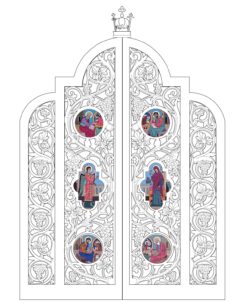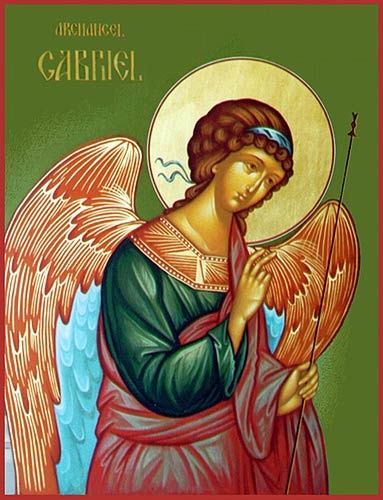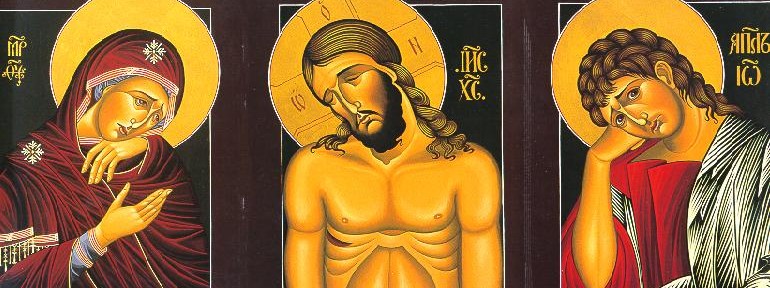Gabriel is the announcer of the Incarnation of the Son of God. He is one of the seven archangels who stand before the Throne of God. He appeared to Zacharias about the birth of the Forerunner. Gabriel said of himself, “I am Gabriel, who stand before God” (St. Luke 1:19). His name Gabriel means “Man-God.” The Holy Fathers, in speaking about the Annunciation, interpret that an archangel with such a name was sent to signify who and what He would be like, who must be born of the All-Pure One. Therefore, He will be Man-God, mighty and powerful God. Some of the Fathers understood that this same Gabriel appeared to Joachim and Anna concerning the birth of the Virgin Mary and that Gabriel instructed Moses in the wilderness to write the Book of Genesis. The Holy Fathers think that Gabriel has pre-eminence in the first and greatest order of heavenly powers, that is, the Seraphic Order, since the Seraphims stand closest to God. He is, therefore, one of the seven Seraphims, closest to God. The names of the seven are Michael, Gabriel, Raphael, Uriel, Salathiel, Jegudiel, Barachiel. To this number some even add JEREMIEL. Each one has their own particular service and all are equal in honour. Why did God not send Michael? Because Michael’s service is to suppress the enemies of the Faith of God while Gabriel’s is the mission of announcing the salvation of mankind. Continue reading March 26, 2017 Fourth Sunday of the Great Fast, Octoechos Tone 4; Leave-taking of the Annunciation; Synaxis of the Holy Archangel Gabriel
Author: Michael Winn
March 25, 2017 The Annunciation of Our Most Holy Lady, the Mother of God and Ever-Virgin Mary; Passing into Eternal Life (1944) of Blessed Omelian (Emil) Kovch, Priest of Peremyshliany and Martyr of Majdanek
When the All-Holy Virgin completed the fourteenth year after her birth and was entering her fifteenth year, after having spent eleven years of living and serving in the Temple of Jerusalem, the priests informed her that, according to the Law, she could not remain in the Temple but was required to be betrothed and enter into marriage. What a great surprise to the priests was the answer of the All-Holy Virgin that she had dedicated her life to God and that she desired to remain a Virgin until death, not wanting to enter into marriage with anyone! Then, according to Divine Providence, Zacharias, the high priest and father of the Forerunner, under the inspiration of God, and in agreement with the other priests, gathered twelve unwed men from the Tribe of David to betroth the Virgin Mary to one of them to preserve her virginity and to care for her. She was betrothed to Joseph of Nazareth who was her kinsman. In the house of Joseph, the All-Holy Virgin continued to live as she did in the Temple of Solomon, occupying her time in the reading of Sacred Scripture, in prayer, in Godly-thoughts, in fasting and in handiwork. She rarely went anywhere outside the house nor was she interested in worldly things and events. She spoke very little to anyone, if at all, and never without special need. More frequently she communicated with both of Joseph’s daughters. When the fullness of time had come, as prophesied by Daniel the Prophet, and when God was pleased to fulfill His promise to the banished Adam and to the Prophets, the great Archangel Gabriel appeared in the chamber of the All-Holy Virgin and, as some priestly writers wrote, precisely at that same moment when she held open the book of the Prophet Isaiah and was contemplating his great prophecy: “Behold, the virgin shall be with child, and bear a son!” (Isaiah 7:13). Gabriel appeared in all of his angelic brightness and saluted her: “Rejoice, highly favored one! The Lord is with you” (St. Luke 1:28), and the rest in order as it is written in the Gospel of the saintly Luke. With this angelic annunciation and the descent of the Holy Spirit upon the Virgin, the salvation of mankind and restoration of all creation began. The history of the New Testament was opened by the words of the Archangel Gabriel: “Rejoice, highly favored one” This is to imply that the New Testament was to signify joy to mankind and to all created things. It is from this that the Annunciation is considered not only a great feast, but a joyful feast as well.
March 24, 2017 Friday of the Fourth Week of the Great Fast Liturgy of the Presanctified Gifts on the Eve of the Annunciation of the Mother of God
March 22, 2017 Wednesday of the Fourth Week of the Great Fast Liturgy of the Presanctified Gifts at which we commemorate the Holy Venerable-Martyr Nikon and His Disciples, Martyred with Him (270-75)
March 19, 2017 Third Sunday of the Great Fast – Veneration of the Precious and Life-Giving Cross, Octoechos Tone 3; Holy Martyrs Chrysanthus and Daria
Not only the Third Sunday of Great Lent, but the week that follows, are devoted to welcoming the Precious Cross of Christ. This adoration of the Cross does not have a penitential character, but rather the opposite: “through the Cross joy has come to the whole world.” Having reached the midpoint of Lent we take refreshment, as though at a spiritual oasis, in the shade of the Cross, which is the banner and emblem of Christ’s victory. The Cross is a sign of our joy in Christ’s triumph. The liturgical texts express this joy; all the hymns in praise of the Cross have a victorious note to them. The Canon of Sunday Matins resembles the Paschal Canon of Saint John of Damascus. Continue reading March 19, 2017 Third Sunday of the Great Fast – Veneration of the Precious and Life-Giving Cross, Octoechos Tone 3; Holy Martyrs Chrysanthus and Daria
March 17, 2017 Friday of the Third Week of the Great Fast Liturgy of the Presanctified Gifts at which we commemorate Our Holy Father Cyril, Archbishop of Jerusalem (386)
March 15, 2017 Wednesday of the Third Week of the Great Fast Liturgy of the Presanctified Gifts at which we commemorate the Holy Martyrs Sabinus and Papas (284-305)
March 12, 2017 Second Sunday of the Great Fast: St. Gregory of Palamas; Octoechos Tone 2; Venerable Father and Confessor Theophanes of Sigriana; Holy Father Gregory the Dialogist, Pope of Rome
The Second Sunday of Lent is kept as a feast of Saint Gregory Palamas, the Archbishop of Thessaloniki in the fourteenth century. Like the restoration of the holy icons, this memorial of Saint Gregory has to do with historical events, but also relates to our understanding of the Christian vocation, and the possibility for every Christian to achieve genuine holiness. Saint Gregory taught that all Christians are called to union with God, which is the object of the Christian life. Continue reading March 12, 2017 Second Sunday of the Great Fast: St. Gregory of Palamas; Octoechos Tone 2; Venerable Father and Confessor Theophanes of Sigriana; Holy Father Gregory the Dialogist, Pope of Rome





